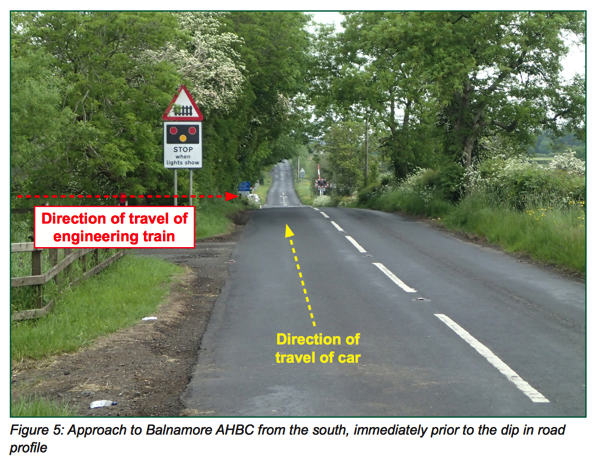Monday Accident & Lessons Learned: UK Rail Accident Investigation Branch Releases Report on Accident at Balnamore Level Crossing, Ballymoney, Northern Ireland, 31 May 2013

Here’s the Summary from the report:
At approximately 03:10 hrs on Friday, 31 May 2013, a car driver was forced totake action in order to avoid colliding with an engineering train that was traversing Balnamore automatic half barrier level crossing, which is located between Coleraine and Ballymoney stations on Northern Ireland Railways’ Belfast to Londonderry/ Derry line. The car subsequently struck metal fencing forming part of the crossing, causing minor injuries to its two occupants and damage to the car. The crew of the engineering train spoke with the car driver and then continued work without reporting the accident.
At the time of the accident, the engineering train was undertaking weed-spraying operations within a possession of the line, which meant that operation of passenger trains on the line had been suspended. Because the line was under possession, Balnamore level crossing, which is normally automatically operated by approaching trains, was being operated manually via its local controls. However, as the train passed over the crossing, its half barriers had not been lowered and its road traffic signals were not operating, even though this was required by the railway rules relating to this type of level crossing. This meant that the car driver did not have enough warning to stop his car before the level crossing became occupied by the train.
The RAIB has found that the team responsible for undertaking weed-spraying was routinely not complying with the rules relating to the operation of automatic half barrier level crossings within possessions. This was probably due to a combination of factors, including the team possibly having a low perception of the risks presented by this non-compliance and a desire by them to complete the weed-spraying more quickly. In addition, the team may have been influenced by the status of rules relating to the local control of other types of crossing in possessions and the method of work adopted at level crossings during a recent project.
The RAIB has also found that this non-compliance was not detected or corrected by safety checks conducted by Northern Ireland Railways. In addition, the investigation identified that the appointment of additional competent staff to operate crossings within the possession may have prevented the accident from occurring.
The RAIB has identified three key learning points. These are: 1) that the person in charge of a possession should correctly complete the form intended to help them keep track of level crossings; 2) that boarding moving trains, where it is prohibited, should be avoided; and 3) that accidents should be reported.
The RAIB has also made three recommendations addressed to Northern Ireland Railways. These relate to: 1) ensuring that activities undertaken at level crossings within possessions are subject to effective risk controls; 2) ensuring that method statements relating to track engineering are supported by risk assessments; and 3) increasing the opportunities for non-compliances to be detected and corrected.
For the complete report, CLICK HERE.



